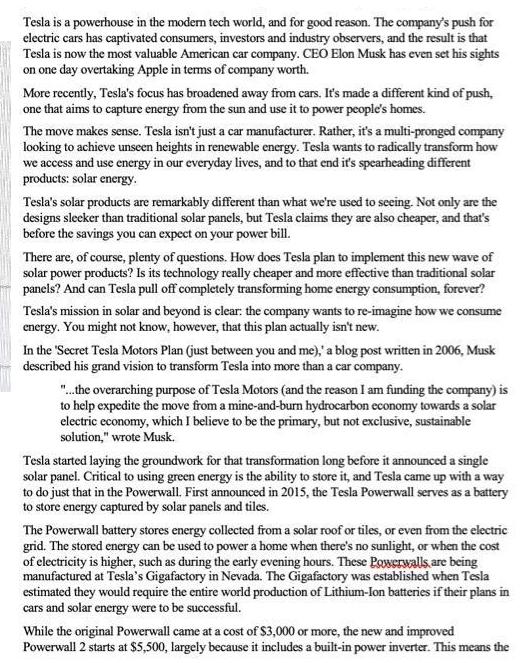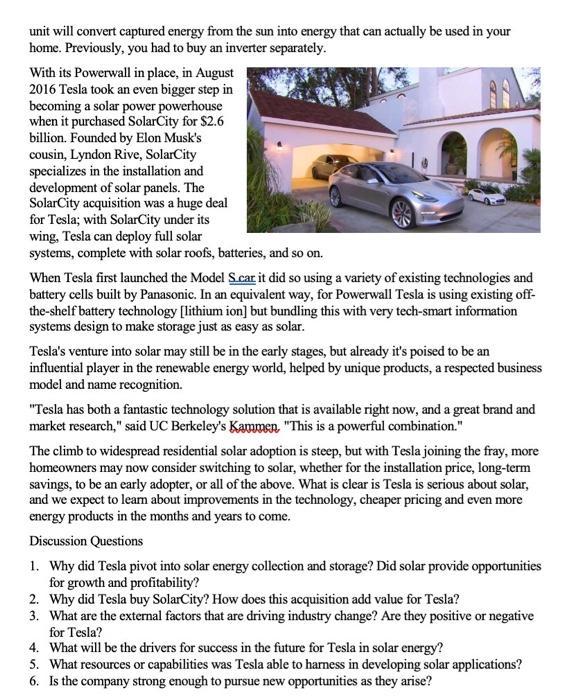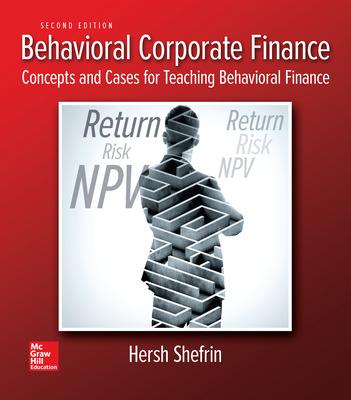Tesla is a powerhouse in the modern tech world, and for good reason. The company's push for electric cars has captivated consumers, investors and


Tesla is a powerhouse in the modern tech world, and for good reason. The company's push for electric cars has captivated consumers, investors and industry observers, and the result is that Tesla is now the most valuable American car company. CEO Elon Musk has even set his sights on one day overtaking Apple in terms of company worth. More recently, Tesla's focus has broadened away from cars. It's made a different kind of push, one that aims to capture energy from the sun and use it to power people's homes. The move makes sense. Tesla isn't just a car manufacturer. Rather, it's a multi-pronged company looking to achieve unseen heights in renewable energy. Tesla wants to radically transform how we access and use energy in our everyday lives, and to that end it's spearheading different products: solar energy. Tesla's solar products are remarkably different than what we're used to seeing. Not only are the designs sleeker than traditional solar panels, but Tesla claims they are also cheaper, and that's before the savings you can expect on your power bill. There are, of course, plenty of questions. How does Tesla plan to implement this new wave of solar power products? Is its technology really cheaper and more effective than traditional solar panels? And can Tesla pull off completely transforming home energy consumption, forever? Tesla's mission in solar and beyond is clear: the company wants to re-imagine how we consume energy. You might not know, however, that this plan actually isn't new. In the 'Secret Tesla Motors Plan (just between you and me),' a blog post written in 2006, Musk described his grand vision to transform Tesla into more than a car company. "...the overarching purpose of Tesla Motors (and the reason I am funding the company) is to help expedite the move from a mine-and-burn hydrocarbon economy towards a solar electric economy, which I believe to be the primary, but not exclusive, sustainable solution," wrote Musk. Tesla started laying the groundwork for that transformation long before it announced a single solar panel. Critical to using green energy is the ability to store it, and Tesla came up with a way to do just that in the Powerwall. First announced in 2015, the Tesla Powerwall serves as a battery to store energy captured by solar panels and tiles. The Powerwall battery stores energy collected from a solar roof or tiles, or even from the electric grid. The stored energy can be used to power a home when there's no sunlight, or when the cost of electricity is higher, such as during the early evening hours. These Powerwalls, are being manufactured at Tesla's Gigafactory in Nevada. The Gigafactory was established when Tesla estimated they would require the entire world production of Lithium-Ion batteries if their plans in cars and solar energy were to be successful. While the original Powerwall came at a cost of $3,000 or more, the new and improved Powerwall 2 starts at $5,500, largely because it includes a built-in power inverter. This means the unit will convert captured energy from the sun into energy that can actually be used in your home. Previously, you had to buy an inverter separately. With its Powerwall in place, in August 2016 Tesla took an even bigger step in becoming a solar power powerhouse when it purchased SolarCity for $2.6 billion. Founded by Elon Musk's cousin, Lyndon Rive, SolarCity specializes in the installation and development of solar panels. The SolarCity acquisition was a huge deal for Tesla; with SolarCity under its wing, Tesla can deploy full solar systems, complete with solar roofs, batteries, and so on. When Tesla first launched the Model S car it did so using a variety of existing technologies and battery cells built by Panasonic. In an equivalent way, for Powerwall Tesla is using existing off- the-shelf battery technology [lithium ion] but bundling this with very tech-smart information systems design to make storage just as easy as solar. Tesla's venture into solar may still be in the early stages, but already it's poised to be an influential player in the renewable energy world, helped by unique products, a respected business model and name recognition. "Tesla has both a fantastic technology solution that is available right now, and a great brand and market research," said UC Berkeley's Kammen, "This is a powerful combination." The climb to widespread residential solar adoption is steep, but with Tesla joining the fray, more homeowners may now consider switching to solar, whether for the installation price, long-term savings, to be an early adopter, or all of the above. What is clear is Tesla is serious about solar, and we expect to learn about improvements in the technology, cheaper pricing and even more energy products in the months and years to come. Discussion Questions 1. Why did Tesla pivot into solar energy collection and storage? Did solar provide opportunities for growth and profitability? 2. Why did Tesla buy SolarCity? How does this acquisition add value for Tesla? 3. What are the external factors that are driving industry change? Are they positive or negative for Tesla? 4. What will be the drivers for success in the future for Tesla in solar energy? 5. What resources or capabilities was Tesla able to harness in developing solar applications? 6. Is the company strong enough to pursue new opportunities as they arise?
Step by Step Solution
There are 3 Steps involved in it
Step: 1
Discussion Questions 1 Tesla pivoted into solar energy collection and storage to expedite the transition from a hydrocarbon economy to a solar electri...
See step-by-step solutions with expert insights and AI powered tools for academic success
Step: 2

Step: 3

Ace Your Homework with AI
Get the answers you need in no time with our AI-driven, step-by-step assistance
Get Started


